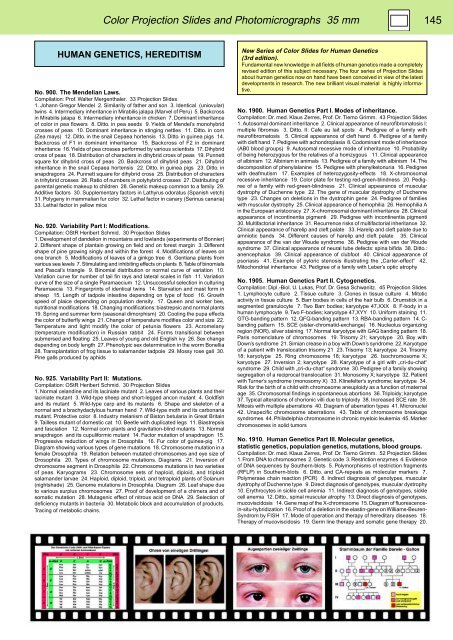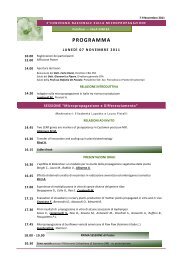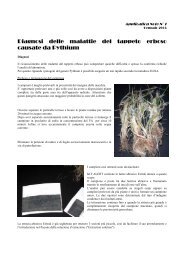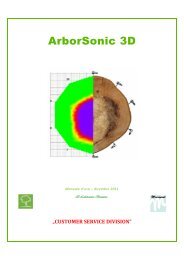BIOLOGY - microscopia.info
BIOLOGY - microscopia.info
BIOLOGY - microscopia.info
Create successful ePaper yourself
Turn your PDF publications into a flip-book with our unique Google optimized e-Paper software.
Color Projection Slides and Photomicrographs 35 mm 145<br />
HUMAN GENETICS, HEREDITISM<br />
No. 900. The Mendelian Laws.<br />
Compilation: Prof. Walter Mergenthaler. 33 Projection Slides<br />
1. Johann Gregor Mendel 2. Similarity of father and son 3. Identical (uniovular)<br />
twins 4. Intermediary inheritance in Mirabilis jalapa (Marvel of Peru) 5. Backcross<br />
in Mirabilis jalapa 6. Intermediary inheritance in chicken 7. Dominant inheritance<br />
of color in pea flowers 8. Ditto. in pea seeds 9. Yields of Mendel’s monohybrid<br />
crosses of peas 10. Dominant inheritance in stinging nettles 11. Ditto. in corn<br />
(Zea mays) 12. Ditto. in the snail Cepaea hortensis 13. Ditto. in guinea pigs 14.<br />
Backcross of F1 in dominant inheritance 15. Backcross of F2 in dominant<br />
inheritance 16. Yields of pea crosses performed by various scientists 17. Dihybrid<br />
cross of peas 18. Distribution of characters in dihybrid cross of peas 19. Punnett<br />
square for dihybrid cross of peas 20. Backcross of dihybrid peas 21. Dihybrid<br />
inheritance in the snail Cepaea hortensis 22. Ditto. in guinea pigs 23. Ditto. in<br />
snapdragons 24. Punnett square for dihybrid cross 25. Distribution of characters<br />
in trihybrid crosses 26. Ratio of numbers in polyhybrid crosses 27. Distributing of<br />
parental genetic makeup to children 28. Genetic makeup common to a family 29.<br />
Additive factors 30. Supplementary factors in Lathyrus odoratus (Spanish vetch)<br />
31. Polygeny in mammalian fur color 32. Lethal factor in canary (Serinus canaria)<br />
33. Lethal factor in yellow mice<br />
No. 920. Variability Part I: Modifications.<br />
Compilation: OStR Heribert Schmid. 30 Projection Slides<br />
1. Development of dandelion in mountains and lowlands (experiments of Bonnier)<br />
2. Different shape of plantain growing on field and on forest margin 3. Different<br />
shape of pine growing singly and within the forest 4. Modifications of leaves on<br />
one branch 5. Modifications of leaves of a ginkgo tree 6. Gentiana plants from<br />
various sea levels 7. Stimulating and inhibiting effects on plants 8. Table of binomials<br />
and Pascal’s triangle 9. Binomial distribution or normal curve of variation 10.<br />
Variation curve for number of tail fin rays and lateral scales in fish 11. Variation<br />
curve of the size of a single Paramaecium 12. Unsuccessful selection in culturing<br />
Paramaecia 13. Fingerprints of identical twins 14. Starvation and mast form in<br />
sheep 15. Length of tadpole intestine depending on type of food 16. Growth<br />
speed of plaice depending on population density 17. Queen and worker bee,<br />
nutritional modifications 18. Changing modifications: biastrepsic and normal plants<br />
19. Spring and summer form (seasonal dimorphism) 20. Cooling the pupa effects<br />
the color of butterfly wings 21. Change of temperature modifies color and size 22.<br />
Temperature and light modify the color of petunia flowers 23. Acromelany<br />
(temperature modification) in Russian rabbit 24. Forms transitional between<br />
submersed and floating 25. Leaves of young and old English ivy 26. Sex change<br />
depending on body length 27. Phenotypic sex determination in the worm Bonellia<br />
28. Transplantation of frog tissue to salamander tadpole 29. Mossy rose gall 30.<br />
Pine galls produced by aphids<br />
No. 925. Variability Part II: Mutations.<br />
Compilation: OStR Heribert Schmid. 30 Projection Slides<br />
1. Normal celandine and its laciniate mutant 2. Leaves of various plants and their<br />
laciniate mutant 3. Wild-type sheep and short-legged ancon mutant 4. Goldfish<br />
and its mutant 5. Wild-type carp and its mutants 6. Shape and skeleton of a<br />
normal and a brachydactylous human hand 7. Wild-type moth and its carbonaria<br />
mutant. Protective color 8. Industry melanism of Biston betularia in Great Britain<br />
9. Tailless mutant of domestic cat 10. Beetle with duplicated legs 11. Biastrepsis<br />
and fasciation 12. Normal corn plants and gravitation-blind mutants 13. Normal<br />
snapdragon and its cupuliformic mutant 14. Factor mutation of snapdragon 15.<br />
Progressive reduction of wings in Drosophila 16. Fur color of guinea-pig 17.<br />
Diagram showing various types of gene mutations 18. Chromosome mutation in a<br />
female Drosophila 19. Relation between mutated chromosomes and eye size of<br />
Drosophila 20. Types of chromosome mutations. Diagrams 21. Inversion of<br />
chromosome segment in Drosophila 22. Chromosome mutations in two varieties<br />
of peas. Karyograms 23. Chromosome sets of haploid, diploid, and triploid<br />
salamander larvae 24. Haploid, diploid, triploid, and tetraploid plants of Solanum<br />
(nightshade) 25. Genome mutations in Drosophila. Diagram 26. Leaf shape due<br />
to various surplus chromosomes 27. Proof of development of a chimera and of<br />
somatic mutation 28. Mutagenic effect of nitrous acid on DNA 29. Selection of<br />
deficiency mutants in bacteria 30. Metabolic block and accumulation of products.<br />
Tracing of metabolic chains.<br />
New Series of Color Slides for Human Genetics<br />
(3rd edition).<br />
Fundamental new knowledge in all fields of human genetics made a completely<br />
revised edition of this subject necessary. The four series of Projection Slides<br />
about human genetics now on hand have been conceived in view of the latest<br />
developments in research. The new brilliant visual material is highly <strong>info</strong>rmative.<br />
No. 1900. Human Genetics Part I. Modes of inheritance.<br />
Compilation: Dr. med. Klaus Zerres, Prof. Dr. Tiemo Grimm. 43 Projection Slides<br />
1. Autosomal dominant inheritance 2. Clinical appearance of neurofibromatosis I:<br />
multiple fibromas 3. Ditto. II: Cafe au lait spots 4. Pedigree of a family with<br />
neurofibromatosis 5. Clinical appearance of cleft hand 6. Pedigree of a family<br />
with cleft hand 7. Pedigree with achondroplasia 8. Codominant mode of inheritance<br />
(AB0 blood groups) 9. Autosomal recessive mode of inheritance 10. Probability<br />
of being heterozygous for the relatives of a homzygous 11. Clinical appearance<br />
of albinism 12. Albinism in animals 13. Pedigree of a family with albinism 14. The<br />
decomposition of phenylalanine 15. Pedigree with phenylketonuria 16. Pedigree<br />
with deafmutism 17. Examples of heterozygosity-effects 18. X-chromosomal<br />
recessive inheritance 19. Color plate for testing red-green-blindness 20. Pedigree<br />
of a family with red-green-blindness 21. Clinical appearance of muscular<br />
dystrophy of Duchenne type 22. The gene of muscular dystrophy of Duchenne<br />
type 23. Changes on deletions in the dystrophin gene 24. Pedigree of families<br />
with muscular dystrophy 25. Clinical appearance of hemophilia 26. Hemophilia A<br />
in the European aristocracy 27. X-chromosomal dominant inheritance 28. Clinical<br />
appearance of incontinentia pigmenti 29. Pedigree with incontinentia pigmenti<br />
30. Multifactorial inheritance 31. Recurrence risks of multifactorial inheritance 32.<br />
Clinical appearance of harelip and cleft palate 33. Harelip and cleft palate due to<br />
amniotic bands 34. Different causes of harelip and cleft palate 35. Clinical<br />
appearance of the van der Woude syndrome 36. Pedigree with van der Woude<br />
syndrome 37. Clinical appearance of neural tube defects: spina bifida 38. Ditto.:<br />
anencephalus 39. Clinical appearance of clubfoot 40. Clinical appearance of<br />
psoriasis 41. Example of pyloric stenosis illustrating the „Carter-effect“ 42.<br />
Mitochondrial inheritance 43. Pedigree of a family with Leber’s optic atrophy<br />
No. 1905. Human Genetics Part II. Cytogenetics.<br />
Compilation: Dipl.-Biol. U. Lukas, Prof. Dr. Gesa Schwanitz. 45 Projection Slides<br />
1. Lymphocyte culture 2. Tissue culture 3. Clones in tissue culture 4. Mitotic<br />
activity in tissue culture 5. Barr bodies in cells of the hair bulb 6. Drumstick in a<br />
segmented granulocyte 7. Two Barr bodies; karyotype 47,XXX 8. F-body in a<br />
human lymphocyte 9. Two F-bodies; karyotype 47,XYY 10. Uniform staining 11.<br />
GTG-banding pattern 12. QFQ-banding pattern 13. RBA-banding pattern 14. C-<br />
banding pattern 15. SCE (sister-chromatid-exchange) 16. Nucleolus organizing<br />
region (NOR), silver staining 17. Normal karyotype with GAG banding pattern 18.<br />
Paris nomenclature of chromosomes 19. Trisomy 21; karyotype 20. Boy with<br />
Down’s syndrome 21. Simian crease in a boy with Down’s syndrome 22. Karyotype<br />
of a patient with translocation trisomy 21 23. Trisomy 13; karyotype 24. Trisomy<br />
18; karyotype 25. Ring chromosome 18; karyotype 26. Isochromosome X;<br />
karyotype 27. Inversion 2; karyotype 28. Karyotype of a girl with „cri-du-chat“<br />
syndrome 29. Child with „cri-du-chat“ syndrome 30. Pedigree of a family showing<br />
segregation of a reciprocal translocation 31. Monosomy X; karyotype 32. Patient<br />
with Turner’s syndrome (monosomy X) 33. Klinefelter’s syndrome; karyotype 34.<br />
Risk for the birth of a child with chromosome aneuploidy as a function of maternal<br />
age 35. Chromosomal findings in spontaneous abortions 36. Triploidy; karyotype<br />
37. Typical alterations of chorionic villi due to triploidy 38. Increased SCE rate 39.<br />
Mitosis with multiple aberrations 40. Diagram of aberration types 41. Micronuclei<br />
42. Unspecific chromosome aberrations 43. Table of chromosome breakage<br />
syndromes 44. Philadelphia chromosome in chronic myeloic leukemia 45. Marker<br />
chromosomes in solid tumors<br />
No. 1910. Human Genetics Part III. Molecular genetics,<br />
statistic genetics, population genetics, mutations, blood groups.<br />
Compilation: Dr. med. Klaus Zerres, Prof. Dr. Tiemo Grimm. 52 Projection Slides<br />
1. From DNA to chromosomes 2. Genetic code 3. Restriction enzymes 4. Evidence<br />
of DNA sequences by Southern-blots 5. Polymorphisms of restriction fragments<br />
(RFLP) in Southern-blots 6. Ditto. and CA-repeats as molecular markers 7.<br />
Polymerase chain reaction (PCR) 8. Indirect diagnosis of genotypes, muscular<br />
dystrophy of Duchenne type 9. Direct diagnosis of genotypes, muscular dystrophy<br />
10. Erythrocytes in sickle cell anemia 11. Indirect diagnosis of genotypes, sickle<br />
cell anemia 12. Ditto., spinal muscular atrophy 13. Direct diagnosis of genotypes,<br />
mucoviscidosis 14. Gene map of the X-chromosome 15. Diagram of fluorescencein-situ-hybridization<br />
16. Proof of a deletion in the elastin-gene on Williams-Beuren-<br />
Syndrom by FISH 17. Mode of operation and therapy of hereditary diseases 18.<br />
Therapy of mucoviscidosis 19. Germ line therapy and somatic gene therapy 20.







